

<< Go Back up to Region ‘United Kingdom: London’
| Follow Mike Hume’s Historic Theatre Photography: |  |
 |
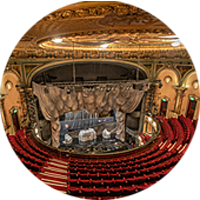
Architects: Charles J. Phipps (current building), John Vanbrugh (first theatre), Michael Novosielski (second theatre), Charles Lee and Sons (third theatre), William Pain (third theatre associate architect)
Current (fourth) Theatre Opened: 28th April 1897 (128 years ago)
First Theatre Opened: 9th April 1705
Second Theatre Opened: 26th March 1791
Third Theatre Opened: 1868
Renamed from Her Majesty’s Theatre: 6th May 2023
Former Names: Queen’s Theatre, King’s Theatre, Italian Opera House, Her Majesty’s Theatre
Website: hismajestystheatre.co.uk 
Telephone: 020 7087 7762 
Address: Haymarket, St. James’s, London, SW1Y 4QL 
His Majesty’s Theatre, as it currently stands, opened in 1897. It is the fourth theatre to have been built on the site, the Queen’s Theatre having opened there in 1705. The theatre is one of only a few theatres throughout the world whose name has changed in line with the gender of the reigning British monarch.

 Detailed Information
Detailed InformationHistory of the first three theatres to have been built on the site:
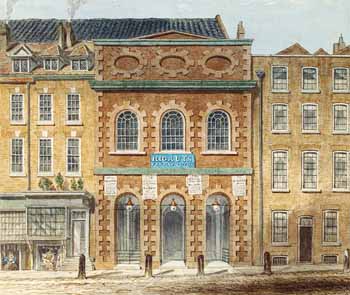
 in 1719 to help support Handel’s productions at the theatre, with sponsors including the Prince of Wales. Handel was a partner in the theatre’s management from the late 1720s to 1734.
in 1719 to help support Handel’s productions at the theatre, with sponsors including the Prince of Wales. Handel was a partner in the theatre’s management from the late 1720s to 1734.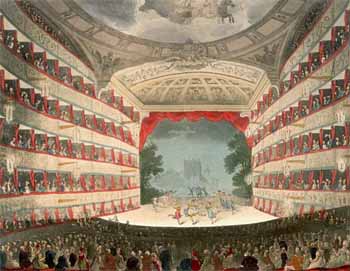
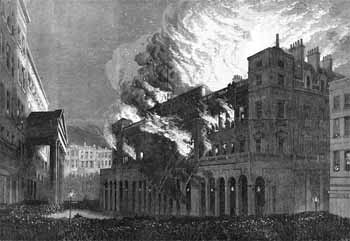
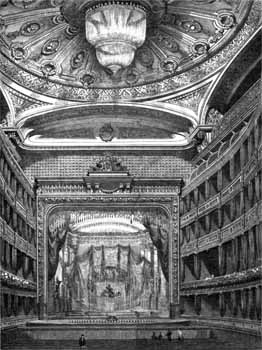
Current Building (1897)
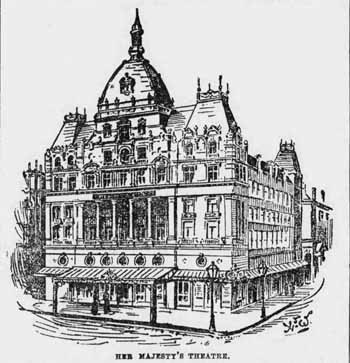
In the early 1890s architect Charles J. (C.J.) Phipps was commissioned to design the new theatre, and in 1896 financing was agreed with Herbert Beerbohm Tree, manager of the Theatre Royal, Haymarket just across the street. The design of Her Majesty’s Theatre would end up being the last of C.J. Phipps’ work to be completed within his lifetime.
The exterior design of the theatre on Haymarket was a symmetrical pair with the Carlton Hotel next door, which filled-in the rest of the block, occupied a large part of the site of the previous theatre, and was also designed by Phipps. The hotel was badly damaged in the Second World War and was ultimately replaced by New Zealand House in the late 1950s, home of the New Zealand High Commission.
The theatre’s auditorium consists of three primary levels (Stalls/Pit, Dress Circle, and Upper Circle/Gallery). Three boxes on each side of the stage are flanked by gigantic Corinthian columns of marble; the box “stacks” each side framing the proscenium arch with a coffered sounding board above (note: all of this survives intact but was painted black for many years during residence of The Phantom of the Opera in its original form, from 1986 to 2020). Interior decoration of the theatre was by W.H. Romaine Walker and was executed in the style of Louis XIV. The theatre’s original seating capacity was 1,320.
The theatre opened on 28th April 1897 with the play The Seats of the Mighty by Gilbert Parker. The play was not greatly received, however the theatre received high praise.
Herbert Beerbohm Tree and his actress wife would star in many of the presentations at Her Majesty’s, however latterly the public grew weary of Tree’s performances finding his acting methods stuck in the past. Tree and his wife had an apartment in the top level of the building which included a banqueting hall in the high-ceilinged French-style dome where he was known to entertain guests.
In 1901 the theatre’s named changed to His Majesty’s Theatre following the accession of Edward VII to the throne. Edward then allegedly gave permission for the theatre’s name to be changed in perpetuity according to the gender of the reigning monarch, however no proof for this claim has been found to date despite extensive research.
There are a small number of other theatres, both existing and demolished, whose names have changed according to the British monarch:
 in Melbourne, Victoria (Australia), originally opened as the Alexandra Theatre, changed name to His Majesty’s Theatre in 1924, then reverted back to Her Majesty’s Theatre in May 1953.
in Melbourne, Victoria (Australia), originally opened as the Alexandra Theatre, changed name to His Majesty’s Theatre in 1924, then reverted back to Her Majesty’s Theatre in May 1953. in Ballarat, Victoria (Australia) opened in 1875 and also changed name to His Majesty’s Theatre in 1924, then back to Her Majesty’s Theatre in the early 1950s.
in Ballarat, Victoria (Australia) opened in 1875 and also changed name to His Majesty’s Theatre in 1924, then back to Her Majesty’s Theatre in the early 1950s.In 1904 Herbert Beerbohm Tree founded The Academy of Dramatic Art (now the Royal Academy of Dramatic Art – RADA  ) at the theatre, when he gave acting classes in his apartment in the dome of the building. Even after the group moved to a different location, Tree still employed large numbers of RADA graduates at his theatre.
) at the theatre, when he gave acting classes in his apartment in the dome of the building. Even after the group moved to a different location, Tree still employed large numbers of RADA graduates at his theatre.

The theatre’s large stage naturally lent itself to musical theatre, and starting in 1916 Chu Chin Chow ran for an unprecedented 2,235 performances. Oh, Kay!, which had opened the Mayan Theatre in Los Angeles in August 1927, premiered at Her Majesty’s a month later and ran for over 200 performances. The theatre would go on to host many other successful runs including Noel Coward’s Bitter Sweet in 1929.
In February 1952, with Elizabeth II’s accession to the throne, the theatre’s name changed to Her Majesty’s Theatre. Notable musicals before and after this time include The Merry Widow in 1943, Brigadoon in 1949, Paint Your Wagon in 1953, West Side Story in 1958, Gilbert & Sullivan delights The Pirates of Penzance and H.M.S. Pinafore in repertory in 1962, and Fiddler on the Roof in 1967 which ran for over 2,000 performances through to 1971. The 70s and 80s welcomed Pippin, Jeeves, The Good Companions, and Bugsy Malone among others.
The popular live entertainment show Live from Her Majesty’s  was broadcast live from the theatre on Saturday nights from early 1983 to late 1985. The 15th April 1984 broadcast featured comedian Tommy Cooper who collapsed live on stage and subsequently died after suffering a major heart attack.
was broadcast live from the theatre on Saturday nights from early 1983 to late 1985. The 15th April 1984 broadcast featured comedian Tommy Cooper who collapsed live on stage and subsequently died after suffering a major heart attack.
On 9th October 1986 Andrew Lloyd Webber’s The Phantom of the Opera  premiered at the theatre. It is the second longest-running musical in London’s West End after Les Misérables.
premiered at the theatre. It is the second longest-running musical in London’s West End after Les Misérables.
Designer Maria Björnson is credited with using the theatre’s Victorian understage machinery to stage a key scene where the Phantom travels across a lake of smoke in a boat. The boat is controlled by modern means however the placement of the other scenic elements, and the manner in which they appear, is indeed based upon the 120+ year-old stage machinery still in place below the stage.
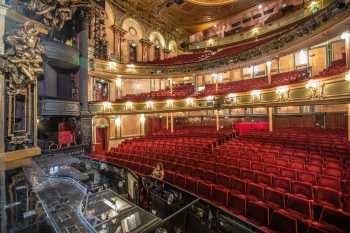
Performances of Phantom ceased on 15th March 2020 in line with the Society of London Theatre’s  announcement that all London West End theatres would be closed effective 16th March 2020 as a result of the Covid-19 pandemic. In late July 2020 Cameron Mackintosh announced
announcement that all London West End theatres would be closed effective 16th March 2020 as a result of the Covid-19 pandemic. In late July 2020 Cameron Mackintosh announced  that the London production of Phantom would close “permanently”, although he added that he was determined to bring the show back to London’s West End in the future.
that the London production of Phantom would close “permanently”, although he added that he was determined to bring the show back to London’s West End in the future.
After an extended closure, Phantom reopened at Her Majesty’s on 27th July 2021, in a “new version of the original Phantom production”. Producer Cameron Mackintosh stated that “Although many of our brilliant original creative colleagues including Hal Prince, Maria Björnson, and Gillian Lynne are sadly no longer with us, their work lives on inspiring our new creative team to stage the Phantom afresh, as if it was a brand new production”.
The new production is lit entirely with LED lighting, aside from spots on the conductor which come courtesy of a couple of old Rank Strand Patt. 23N spotlights. The rotating cloud effects disc on the front of the first circle is also original to the 1986 production, although now projected using an LED light source. Unusual Rigging upgraded the theatre’s grid  to cope with the heavier scenery used in the new production, and extensive improvements were made to the fabric of the building which was found to be in fairly urgent need of repair.
to cope with the heavier scenery used in the new production, and extensive improvements were made to the fabric of the building which was found to be in fairly urgent need of repair.
In mid-April 2023 it was reported  that the theatre would be renamed His Majesty’s Theatre on 6th May 2023 to mark the coronation of King Charles III. We are extremely proud to have been asked to contribute our research into the report which recommended the name change to LW Theatres’ owner Andrew Lloyd Webber.
that the theatre would be renamed His Majesty’s Theatre on 6th May 2023 to mark the coronation of King Charles III. We are extremely proud to have been asked to contribute our research into the report which recommended the name change to LW Theatres’ owner Andrew Lloyd Webber.
 Movie, TV & Music Video Appearances
Movie, TV & Music Video Appearances
 . Seasons 1-3 (1982-1985).
. Seasons 1-3 (1982-1985).

 . Episode 2: Her Majesty’s Theatre.
. Episode 2: Her Majesty’s Theatre. Video from our YouTube channel:
Video from our YouTube channel: Listed/Landmark Building Status
Listed/Landmark Building Status (14th January 1970)
(14th January 1970) How do I visit His Majesty’s Theatre?
How do I visit His Majesty’s Theatre?As of early 2023 the theatre does not offer regular tours. You can check for any upcoming special events, or book tickets for the current show, on the LW Theatres website  .
.
The London Festival of Architecture ran tours of the theatre in June 2019 and they may offer these tours again in the future; keep an eye on their website  for updates.
for updates.
 Further Reading
Further Reading , the premier Music Hall (Vaudeville) and Theatre History website in the UK.
, the premier Music Hall (Vaudeville) and Theatre History website in the UK. contains detailed history, drawings, a timeline of significant dates, and detailed history of the theatre.
contains detailed history, drawings, a timeline of significant dates, and detailed history of the theatre. contains a good summary and architectural description of the theatre.
contains a good summary and architectural description of the theatre. contains a selection of photographs not seen elsewhere.
contains a selection of photographs not seen elsewhere. , from 1705 to the present.
, from 1705 to the present. showing the load-out of the original set, and subsequently the empty theatre, in late 2020.
showing the load-out of the original set, and subsequently the empty theatre, in late 2020. , following the shutdown of the production due to the Covid-19 pandemic.
, following the shutdown of the production due to the Covid-19 pandemic. by owners LW Theatres
by owners LW Theatres  in mid-April 2022.
in mid-April 2022. , by Christine Ferdinand, published by Oxford University Press. ISBN 9780199297474.
, by Christine Ferdinand, published by Oxford University Press. ISBN 9780199297474. , by Edwin O. Sachs, first published in 1897, reissued 1968 by Benjamin Bloom, Inc. ISBN 0405089066.
, by Edwin O. Sachs, first published in 1897, reissued 1968 by Benjamin Bloom, Inc. ISBN 0405089066. , by Mike Kilburn and Alberto Arzoz, published by New Holland Publishers Uk Ltd. ISBN 1843300699.
, by Mike Kilburn and Alberto Arzoz, published by New Holland Publishers Uk Ltd. ISBN 1843300699. , by Michael Coveney and Peter Dazeley, published by France Lincoln. ISBN 0711238618.
, by Michael Coveney and Peter Dazeley, published by France Lincoln. ISBN 0711238618. , by John Earl & Michael Sell, published by A&C Black. ISBN 0713656883.
, by John Earl & Michael Sell, published by A&C Black. ISBN 0713656883. Technical Information
Technical Information Photos of His Majesty’s Theatre
Photos of His Majesty’s TheatrePhotographs copyright © 2002-2025 Mike Hume / Historic Theatre Photos unless otherwise noted.
Text copyright © 2017-2025 Mike Hume / Historic Theatre Photos.
For photograph licensing and/or re-use contact us here  . See our Sharing Guidelines here
. See our Sharing Guidelines here  .
.
| Follow Mike Hume’s Historic Theatre Photography: |  |
 |